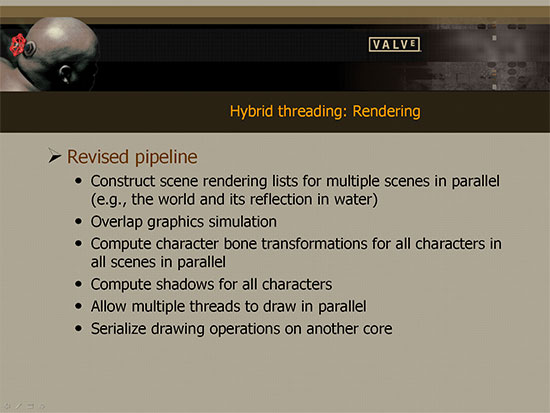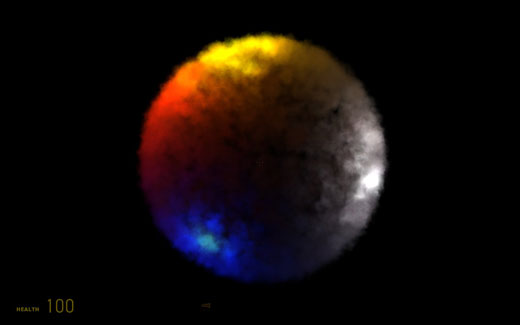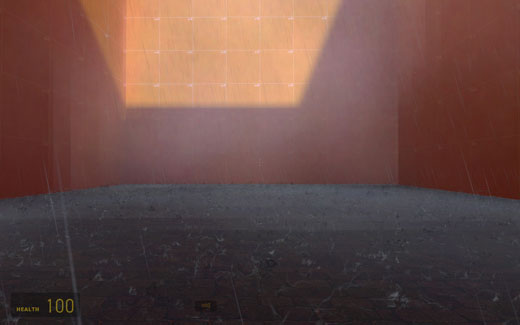Valve Hardware Day 2006 - Multithreaded Edition
by Jarred Walton on November 7, 2006 6:00 AM EST- Posted in
- Trade Shows
The Future of Gaming?
The first thing that Valve had to do was look at the threading models available: how can they distribute work to the cores? Having decided on hybrid threading, the next step was to decide what sort of software tools were needed, and to create those tools as necessary. Most of that work should now be done or nearing completion, so the big question is with the threading in place, how are they going to apply the power available? Up to this point we have primarily been concerned with what multithreading is and how Valve has attempted to implement the technology. All this talk about multi-core support sounds good, but without a compelling need for the technology it really isn't going to mean much to most people.
We've already seen quite a few games that are almost entirely GPU bound, so some might argue that the GPU needs to get faster before we even worry about the CPU. As Valve sees things, however, the era of pretty visuals is coming to an end. We have now reached the point where in terms of graphics most people are more than satisfied with what they see. Games like Oblivion look great, but it's still very easy to tell that you're not in a real world. This does not mean that better graphics are not important, but Valve is now interested in taking a look at the rest of the story and what can be done beyond graphics. Valve also feels that their Source engine has traditionally been more CPU limited anyway, so they were very interested in techniques that would allow them to improve CPU performance.
Before we get to the stuff beyond graphics, though, let's take a quick look at what's being done to improve graphics. The hybrid threading approach to the rendering process can be thought of as follows:


At present, everything up to drawing in the rendering pipeline is essentially CPU bound, and even the drawing process can be at least partially CPU bound with tasks such as generating dynamic vertex buffers. The second image above shows the revised pipeline and how you might approach it. For example, spending CPU time building the vertex buffer makes the GPU more efficient, so even in cases where you are mostly GPU limited you can still improve performance by using additional CPU power. Another item related to graphics is the animations and bone transformations that need to be done prior to rendering a scene. Bone transforms can be very time consuming, and as you add more creatures the CPU limitations become more and more prevalent. One of the solutions is to simply cheat, either by reducing the complexity of the animations, cloning one model repeatedly, or by other methods; but with more processor power it becomes possible to actually do full calculations on more units.

A specific Half-Life example that was given is that you might have a scene with 200 Combine soldiers standing in rank, and the animations for that many units requires a huge chunk of time. All of the bone transformations can be done in parallel, so more CPU power available can directly equate to having more entities on screen at the same time.
With more computational power available to do animations, the immersiveness of the game world can also be improved. Right now, the amount of interaction that most creatures have with the environment is relatively limited. If you think about the way people move through the real world, they are constantly bumping into other objects or touching other objects and people. While this would be largely a visual effect, the animations could be improved to show people actually interacting with the environment, so to an onlooker someone running around the side of a house might actually reach out their hand and grab the wall as they turn the corner. Similarly, a sniper lying prone on the top of a hill could actually show their body adjusting to the curvature of the ground rather than simply being a standard "flat" prone position. Two characters running past each other could even bump and react realistically, with arms and bodies being nudged to the side instead of mysteriously gliding past each other.
One final visual aspect that CPU power can influence is the rendering of particle systems. Valve has given us a benchmark that runs through several particle system environments, and we will provide results for the benchmark later. How real world the benchmark is remains to be seen, as it is more of a technology demonstration at present, but the performance increases are dramatic. Not being expert programmers, we also can't say for sure how much of the work that they are doing on the CPU could actually be done elsewhere more efficiently.
Besides the benchmark, though, particle systems can be used to more realistically simulate things like flames and water. Imagine a scene where a campfire gets extinguished by real dynamically generated rain rather than as a canned animation: you could actually see small puffs of smoke and water as individual drops hit the fire, and you might even be able to kick the smoldering embers and watch individual sparks scatter around on the ground. The goal is to create a more immersive world, and the more realistic things look and behave, the more believable the environment. Is all of this necessary? Perhaps not with conventional games that we're used to, but certainly it should open up new gameplay mechanics and that's rarely a bad thing.
The first thing that Valve had to do was look at the threading models available: how can they distribute work to the cores? Having decided on hybrid threading, the next step was to decide what sort of software tools were needed, and to create those tools as necessary. Most of that work should now be done or nearing completion, so the big question is with the threading in place, how are they going to apply the power available? Up to this point we have primarily been concerned with what multithreading is and how Valve has attempted to implement the technology. All this talk about multi-core support sounds good, but without a compelling need for the technology it really isn't going to mean much to most people.
We've already seen quite a few games that are almost entirely GPU bound, so some might argue that the GPU needs to get faster before we even worry about the CPU. As Valve sees things, however, the era of pretty visuals is coming to an end. We have now reached the point where in terms of graphics most people are more than satisfied with what they see. Games like Oblivion look great, but it's still very easy to tell that you're not in a real world. This does not mean that better graphics are not important, but Valve is now interested in taking a look at the rest of the story and what can be done beyond graphics. Valve also feels that their Source engine has traditionally been more CPU limited anyway, so they were very interested in techniques that would allow them to improve CPU performance.
Before we get to the stuff beyond graphics, though, let's take a quick look at what's being done to improve graphics. The hybrid threading approach to the rendering process can be thought of as follows:


At present, everything up to drawing in the rendering pipeline is essentially CPU bound, and even the drawing process can be at least partially CPU bound with tasks such as generating dynamic vertex buffers. The second image above shows the revised pipeline and how you might approach it. For example, spending CPU time building the vertex buffer makes the GPU more efficient, so even in cases where you are mostly GPU limited you can still improve performance by using additional CPU power. Another item related to graphics is the animations and bone transformations that need to be done prior to rendering a scene. Bone transforms can be very time consuming, and as you add more creatures the CPU limitations become more and more prevalent. One of the solutions is to simply cheat, either by reducing the complexity of the animations, cloning one model repeatedly, or by other methods; but with more processor power it becomes possible to actually do full calculations on more units.

A specific Half-Life example that was given is that you might have a scene with 200 Combine soldiers standing in rank, and the animations for that many units requires a huge chunk of time. All of the bone transformations can be done in parallel, so more CPU power available can directly equate to having more entities on screen at the same time.
With more computational power available to do animations, the immersiveness of the game world can also be improved. Right now, the amount of interaction that most creatures have with the environment is relatively limited. If you think about the way people move through the real world, they are constantly bumping into other objects or touching other objects and people. While this would be largely a visual effect, the animations could be improved to show people actually interacting with the environment, so to an onlooker someone running around the side of a house might actually reach out their hand and grab the wall as they turn the corner. Similarly, a sniper lying prone on the top of a hill could actually show their body adjusting to the curvature of the ground rather than simply being a standard "flat" prone position. Two characters running past each other could even bump and react realistically, with arms and bodies being nudged to the side instead of mysteriously gliding past each other.
 |
 |
 |
 |
| Click to enlarge |
One final visual aspect that CPU power can influence is the rendering of particle systems. Valve has given us a benchmark that runs through several particle system environments, and we will provide results for the benchmark later. How real world the benchmark is remains to be seen, as it is more of a technology demonstration at present, but the performance increases are dramatic. Not being expert programmers, we also can't say for sure how much of the work that they are doing on the CPU could actually be done elsewhere more efficiently.
Besides the benchmark, though, particle systems can be used to more realistically simulate things like flames and water. Imagine a scene where a campfire gets extinguished by real dynamically generated rain rather than as a canned animation: you could actually see small puffs of smoke and water as individual drops hit the fire, and you might even be able to kick the smoldering embers and watch individual sparks scatter around on the ground. The goal is to create a more immersive world, and the more realistic things look and behave, the more believable the environment. Is all of this necessary? Perhaps not with conventional games that we're used to, but certainly it should open up new gameplay mechanics and that's rarely a bad thing.










55 Comments
View All Comments
JarredWalton - Tuesday, November 7, 2006 - link
What's with the octal posting? Too many CPU cores running? ;)I deleted the other 7 identical posts for you. Careful with that Post Comment button!
saratoga - Tuesday, November 7, 2006 - link
Server kept timing out when I hit post, so I assumed it wasn't committing :)exdeath - Tuesday, November 7, 2006 - link
You can see my recent comments on this topic here:http://www.dailytech.com/Article.aspx?newsid=4847&...">http://www.dailytech.com/Article.aspx?newsid=4847&...
In my experience relying on atomic CPU swap operations isn't enough as it only works with a single value (32 bit word for example).
While you lock and swap a 32 bit Y value, someone else has just finished reading the newly written X value but beat you to the lock to read the old Y value before you've updated. Clearly whole data structures need to be coherent, not just small atomic values.
Also it’s unusual to modify objects observable states mid frame. Even if you avoided the above example so that the X,Y pair was always updated together, you'd still have different objects interpreting the position as a whole of that object in different places at different times. State data must be held constant to all observers throughout the context of a single frame.
exdeath - Tuesday, November 7, 2006 - link
Even if you avoided the above example so that the X,Y pair was always updated together, you'd still have different objects interpreting the position as a whole of that object in different places at different times in the same frame.JarredWalton - Tuesday, November 7, 2006 - link
I'm assuming your comment is in regards to the PS3/Cell comments on the last page? It's sort of sounds like you're arguing about the way Valve has chosen to go about doing things, or that you disagree with some of the opinions they've expressed concerning other hardware. We have only tried to provide a very high-level overview of what Valve is doing, and we hardly touched the low-level details -- Valve didn't spend a lot of time on specific implementation issues either. All they did was provide us with some information about what they are doing, and a bit of opinion on what they think of the rest of the hardware options.Preventing anything else from doing write operations to the world state during an entire frame in order to keep things coherent is a big problem with multithreading. Apparently Valve has found a way around that, or at least found a way to do it more efficiently, using lock free and wait free algorithms. No, I can't honestly say I really understand what those algorithms do, but if they say it worked better for their code base I'm willing to trust them.
As far as the PS3/Cell processor goes, Valve did say that they have various thoughts on how to properly utilize the architecture. It is simply going to be more difficult to do relative to Xbox 360 and PC. It's not impossible, and companies are definitely going to tackle this problem. As far as how they tackle it, I'm more than a bit rusty on my coding background, and other than high-level details I'm not too concerned how they improve their multithreading code on any specific platform, just that they do it.
exdeath - Tuesday, November 7, 2006 - link
The other issue is OS support.Compiler add-on's or third party APIs can only serve to hide the details or make things look cleaner. But no matter what, the final barrier between the application and the OS are the API calls provided by the OS threading model. Thus no third party implementation can be better than the OS thread model itself in terms of performance and overhead. All those can do is make it easier to use at the top by handling the OS details.
I imagine threading APIs on popular OSes will start to evolve, just like graphics APIs have, once everyone gets on the multi-core bandwagon and starts to get a feel for what's available in the OS APIs and what they'd rather have. So far, Vista's thread pool API looks good, but I still don't see an API to determine such basic things as checking if the work queue is empty and all threads are idle, etc.
Currently I find it's easier to implement my own thread pool manager which does atomic increments and decrements on a 'task count' variable as tasks are entered or completed in the queue. Checking if all tasks are done involves testing that task count against 0 and signaling an event flag that wakes any management threads sleeping until all its work tasks to complete. It also allows for more flexibility in 'before and after' housekeeping as work threads move from task to task and that kind of control isn't offered in the XP’s built in thread pool API, nor Vista’s as far as I can tell.
exdeath - Tuesday, November 7, 2006 - link
Not arguing their methods, a lot of things in this article are in line with my own opinions on multithreading, pretty much the best way to got about it. I'm just pointing out that atomic lock/swap operations in hardware are very primitive and typically operate only on CPU word size values, not entire data structures. Thus it's possible between doing two atomic operations on two variables on one core, another core can get an old version of one variable and a new version of another.core1: compute X
core2: ...
core1: lock/write x
core2: read x, get newly written version
core1: compute Y
core2: read Y, get old y before the update
core1: lock/write Y
core2: ...
The task on core2 is working with inconsistent data, the new X and the old Y. If the task on core2 only uses the data as input, i.e.: AI tracking another AI entity, it has the wrong position, and won't know about it since it has no need to perform its own lock/write (so it never gets the exception that says the value changed). Even if it did, it would have to throw out all work and redo it with the new Y, and then it could possibly change again.
Looping and retrying seems wasteful. And I’m thinking the only way to catch such a hardware error on a failed lock/write update is via exceptions, and handling a thrown exception on an attempt to write a single 32 bit value is very wasteful of CPU cycles.
In my own research I have had excellent results with double buffering any modified data. Each threaded task only updates its hidden internal working state for frame n+1 while all reads to the object are read from its external current state for frame n. At the end of the frame when all parallel tasks have completed, the current/working states are swapped, and the work queue is filled again to start the next frame.
This ensures that throughout the entire computation of frame n+1, the current frame n state will be available to all threads, and guaranteed to not be modified through the duration of current frame. So basically all threads can read anything they want and modify their own data. On PC/360 the time to swap everything is basically nothing; you just swap a few pointers, or a single pointer to an array/structure of current/working data for the frame.
On the PS3 some data copying and moving will be required, but this is mandatory due to design anyway and assisted by an extremely smart and powerful DMAC.
One place to be critical about is message passing between objects since it requires posting (writing) data to be picked up by another object. But the time to lock/post/unlock a queue is negligible compared to the time it takes to process the results leading up to the creation of the message. This is similar to the D3D notion of doing as much as you can before you lock and only do the minimal work needed inside the lock and unlock as quickly as possible.
GhandiInstinct - Tuesday, November 7, 2006 - link
Jarred Walton,My question: Will Valve's games in 2007 be released with specificaitons such as: "For minimum requirements you need a dual-core cpu, for maximum results you need a quad-core" or anything to that nature? Because I seem to be confused in what Valve is working on dual or quad or both or neither or something different, and what I should get to best utilize their games and multi-core software in general.
Thanks.
JarredWalton - Tuesday, November 7, 2006 - link
Episode Two should come out sometime in 2007, and before that happens you will get the multithreading patch affecting previous Source engine titles. Right now, it doesn't sound like anything released in the next year or so from valve is going to require dual cores. That's what I was trying to get out on the conclusion page where I mentioned that they are targeting an "equivalent experience" regardless of what sort of processor you are running.So just like you could turn down the level of detail in Half-Life 2 and run it on DX8 or even DX7 hardware, Source engine should be able to accommodate single core processors all the way up through N-core processors. The engine will spawn as many threads as you have processor cores, with one main thread serving as the controller and N - 1 helper threads. Xbox 360 for example would have 5 helper threads plus the master thread, because it has three course each capable of executing to threads simultaneously.
Patrese - Tuesday, November 7, 2006 - link
Great article, good to see dual-quad cores being used for something in games. By the way, the kitchen examples made me hungry... :)